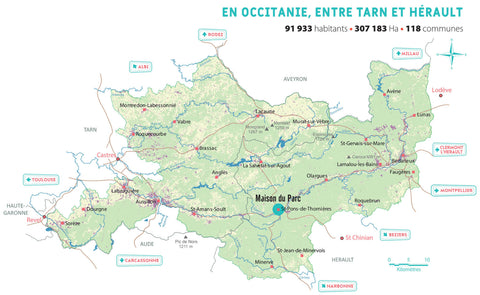Founded in 1973, the Park spans two regions (Midi-Pyrénées and Languedoc-Roussillon) and two departments (Hérault and Tarn). It covers a total of 119 municipalities, or about 90,500 inhabitants.
This mid-mountain territory celebrates the meeting of two noon days: the Midi Toulousain and the Midi Languedocien. Sitting on the dividing line between the Atlantic and the Mediterranean, subject to the two climatic influences that have shaped its identity, it offers extraordinary biological and landscape diversity.
The Haut-Languedoc Regional Natural Park is the most wooded park in France, with a forest cover which represents 60% to 70% of the territory.
Heather moors, dense beech forests, oak coppices, the granite massif of Sidobre, gorges and causses of Minervois: these landscapes are conducive to the flourishing of exceptional flora and fauna. On the territory of the Park, 170 animal species, 250 species of birds and 2,500 species of flowers are listed. In this vast mescladis (“mixture” in Occitan), the different faces of the Park are united by a mountain and southern character.

© Copyright 2018 https://www.parc-haut-languedoc.fr/
The three honeys from the Haut-Languedoc Regional Natural Park selected by Miel Factory are harvested by the young beekeeper Estella, who has just taken over the family beekeeping business.
Heather Honey

The ash heather is a species of the Ericaceae family. Throughout the summer and much of the fall, the most common of all our species of heather crimson moors, glades and woods clear of its myriad small pink bell-shaped flowers. It is also a very good late-season honey plant. The plant's scientific name, Erica, derives from a Greek word meaning "to break." Break the stone, break the urinary stones. Heather has two main properties: it is a diuretic and urinary antiseptic and it facilitates the passage of small kidney stones.
Bees visit the flowers of the heather to collect abundant nectar, as well as significant amounts of pollen. Because of its summer flowering, which lasts late into the late season, ash heather is therefore an interesting food source for the colony in preparation for wintering. During foraging, the bees perforate the base of the corolla in order to directly collect the nectar without coming into contact with the stamens!
The heather gives a honey with powerful and woody flavors. Its color is dark when harvested. Over time its texture takes on a coppery tone with fine to significant crystallization. In the kitchen, it is perfect for making gingerbread. This honey is one of the great French wines.
Harvested on Mont Caroux in the Crouzet forest, it is a honey of character, which remains classic in its texture and taste. It gives amber reflections with caramelized and floral notes.

Scrubland Honey

In France, the scrubland occupies some 400,000 hectares of limestone, stony, filtering and arid land in Provence and Languedoc. Our scrubland arose from the clearing of forests by men, when they began to cultivate land or raise sheep. The limestone slopes of the Languedoc hinterland then supported a lean and low vegetation, a mixture of grasses and shrubs which, over the centuries, has not stopped developing until they spread over thousands of trees. 'hectares. The main occupants of these environments were sheep and a few goats at the time.
Flowering is early and appears in late winter and fades in late spring with heat. This garrigue honey is very aromatic and stays in the mouth for a long time, its texture will remain supple for several months. It is recommended in herbal teas.
Harvested in the Rieu Berlou valley, this scrubland honey is a sweet blend of “sun” flowers; Thyme, Rosemary, Asphodel, Savory, Cistus… It is very pleasant in the mouth and can be tasted with great pleasure.

discover
Holm Oak Honey

The holm oak is a tree 5 to 20 m high, either with a fairly short and twisted single trunk or with multiple trunks, more like a shrub. It grows almost as wide as it is tall and its growth is slow, its wood hard and compact. It can live from 200 to more than 500 years.
The leaves are 3-6 cm long and entire with a smooth, toothed or very thorny margin, similar to small holly leaves.
Holm oak is generally monoecious (with unisex flowers), although there are exceptions. Male individuals have long, hanging yellow-green kittens. Females have small greenish flowers that fruit in acorns.
Harvested in Fos, Holm Oak honey is rare. It is a honeydew, collected by bees on the leaves of oaks from the secretions of aphids. Its discreetly mentholated liquorice aromas release powerful aromas of caramel and dried fruits. Its taste is quite strong, woody with a flowery note.








